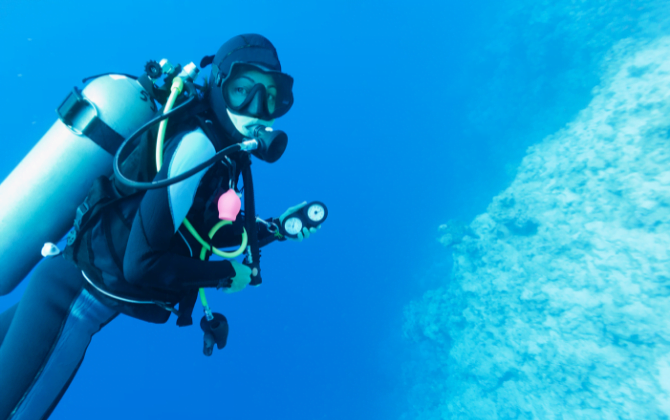
Why Scuba Divers Should Try Freediving: A Personal Perspective from an Scuba diving and Freediving Instructor
Hey everyone, I’m Matt, co-director of OceanSense Freediving here on the Sunny Coast. Over the

Dive computers are an essential piece of equipment for any diver. They play a vital role in the total diving system as they make it easier to monitor your nitrogen absorption levels, remaining gas, and ascent rates.
With so many different models on the market, how do you know which one is right for you?
In this article, we will discuss the different features you should look for when shopping for a dive computer. We’ll talk about things like display, features and prices. So whether you’re a beginner or an experienced diver, read on to learn more about what to look for in a good dive computer!

A dive computer is an electronic device that runs an algorithm every 15-30 seconds that calculates your nitrogen/oxygen/helium absorption at a given depth and time. It measures things like depth, dive time, and ascent rate. The algorithm in computers enables you to stay safe underwater and minimises decompression sickness. Scuba diving computers come in both wrist and console models. Console models are larger and attach to your first stage, they always include a submersible pressure gauge (SPG), while wrist models are smaller and are worn on your wrist. If you purchase a wrist computer, you’ll need to purchase a wireless air transmitter (which attaches to your first stage) and/or an SPG – so you know how much air is in your cylinder.
Type Of Computer
Choosing whether to have a wrist or console is important. Generally speaking wrist computers have more features then console computers, and they are more expensive. A wrist computer is the dive professionals choice.
Wrist computers are easy to locate as they are strapped to your wrist. Console computers are cliped off to your left side, and can get caught on coral/wrecks etc.
Ultimately, it is up to you to decide which style you feel more comfortable wearing on your dive
Algorithms
All of the data that your scuba diving computer collects about depth, time, and pressure is put into an algorithm. This then determines your no-decompression limits (time remaining underwater until saturated with nitrogen). Different models have their own algorithms and some of them are more conservative than others. These conservative algorithms will recommend shorter overall dive times. This is not always a bad thing, ending your dive 5 mins earlier reduces the risk of decompression sickness.
If you are a less experienced diver, it is best to look for a dive computer with a more conservative algorithm.
Display
When shopping for a dive computer, one of the most important things to consider is its display. The best dive computers have easy-to-read displays that show all the relevant information you need while underwater. This includes things like current depth, time remaining, water temperature, and more. It’s also important to look for a dive computer with a backlit color screen. This will come in handy if you’re diving in low-light conditions or murky waters. The Shearwater Teric Dive Computer is a great example of a wrist-style computer that has a very clear, customizable display. You even have the option of changing the watch faces and colors.
Air integration
Having a computer that has an air integration feature is a huge plus. Looking at your wrist computer and seeing all the information on the one screen is fantastic. The other option is having a separate SPG and separate wrist computer. You will be looking at two displays during your dive. Air integration computers are generally $900 + transmitter ($520). So they are the most expensive on the market.
Batteries
Rechargeable vs non-rechargeable. Rechargeable computers like the Aqualung i770R or the Shearwater Peregrine are great, as you don’t have to worry about battery changes every 12-18 months. Battery changes are generally completed at dive shops, as they are pressure tested to 40m after the new battery has been installed. Instore battery changes can cost between $30 and $100 depending on the computer.
Price Range
It’s also important to consider the price range of the dive computer you’re interested in. There are computers available for every budget, so there’s no need to break the bank if you’re not looking to spend a lot of money. On one end of the scale, you have things like the Shearwater Nerd Dive Computer coming in at $2000+. This revolutionary dive computer does not fit on the wrist, it is designed to be secured in your line of sight for maximum visibility and ease of use.
At the other end of the scale, you have affordable options like the Aqualung i200C, which comes in at $499. However, don’t let the price tag fool you because it still has a whole host of great features.
At the end of the day, the best scuba diving computer is one that fits your individual needs and preferences. So take some time to think about what’s important to you and do some research before making a purchase. The team at Scuba World has over 40 years experience and we have all types of computers to test and try out. Drop into our store for a chat, and we’ll ask you a lot of questions regarding your diving history and your diving goals. We will be sure to recommend the perfect computer for you.
Mike McKinnon

Hey everyone, I’m Matt, co-director of OceanSense Freediving here on the Sunny Coast. Over the
Join us Thursday 30th Jan at 5:30pm to hear David Mullins talk about nudibranch defences
Dear members, I would like to take this opportunity to inform you about a few